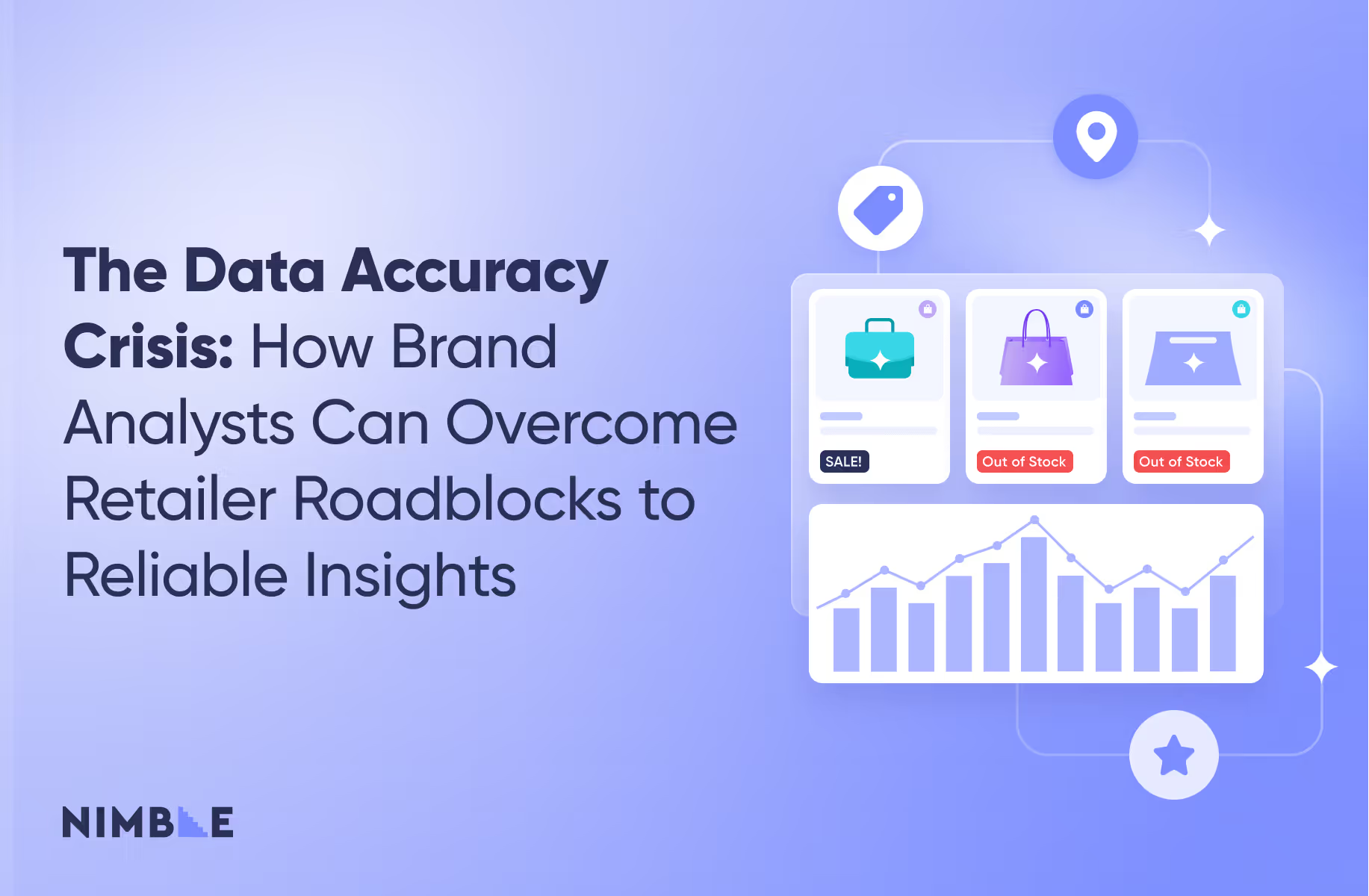Transforming Retail Analytics with Real-Time Competitive Intelligence
Discover actionable strategies for using retail competitive intelligence to win in dynamic markets.

.avif)
Every day, your competitors are making moves you can’t see: slashing prices, launching flash promotions, repositioning products, adjusting their assortments. They’re reacting in real time to market shifts, testing strategies, and capturing customers you didn’t even know you were about to lose.
Retailers who aren’t tracking competitor activity, pricing intelligence, and promotional strategies are flying blind, and making decisions based on partial information. What makes this challenge sharper is the velocity of change. Prices fluctuate intraday. Stock levels deplete and replenish across dozens of channels. Promotions live and die within hours. By the time manual tracking catches up, the moment has already passed.
With automated data pipelines and AI-powered analysis, retailers can stop reacting and start taking the initiative. They can spot competitive threats as they emerge, forecast consumer trends before they peak, and adjust strategies with the agility the market demands.
In this article, we’ll break down how competitive intelligence equips retailers with the insights they need to stay ahead of the curve. You’ll learn how automated data pipelines eliminate manual blind spots, how AI-driven models forecast competitor actions and market trends, and how real-time intelligence transforms pricing, inventory planning, and marketing strategies
Key Takeaways
- Competitive intelligence allows retailers to track competitor pricing, inventory, and marketing strategies in real time.
- Automated data pipelines eliminate manual data collection, improving accuracy and efficiency.
- AI-driven insights help retailers forecast trends and adjust strategies proactively.
- Retailers that integrate real-time CI solutions gain a competitive edge by responding quickly to market shifts.
What Is Retail Competitive Intelligence (CI)?
Retail competitive intelligence is the practice of systematically collecting, analyzing, and applying data about your competitors, market dynamics, and consumer behavior to guide smarter decision-making. CI allows retailers to bring different information streams into a cohesive picture of where their business stands and where the opportunities lie.
With access to high-quality, up-to-date data about their competitors, retailers can:
- Fine-tune pricing strategies by tracking competitors' price fluctuations in real time, responding to market shifts without compromising profitability.
- Develop stronger product strategies by identifying gaps in competitors’ assortments, spotting overperforming or underperforming SKUs, and aligning inventory with actual demand signals.
- Sharpen market positioning by understanding not just what competitors are doing, but how customers are reacting through reviews, social listening, and behavioral data.
With the right technology, retailers can collect and process vast datasets at scale. Automated data pipelines and real-time retail analytics enable them to exchange static reports for dynamic dashboards that monitor competitor movements and customer sentiment continuously.
The result is faster decision-making, fewer missed opportunities, and a proactive approach to staying ahead in the market.
Why Competitive Intelligence Is Essential for Retailers
Staying competitive in retail requires more than gut instinct — it takes a steady stream of actionable insights. Competitive intelligence equips retailers with the tools to not only keep pace with the market but to get ahead of it. From dynamic pricing to customer behavior forecasting, CI provides a clearer view of the playing field and the moves needed to win.
Understanding Competitor Pricing Strategies
Pricing is one of the most immediate—and visible—levers retailers have to stay competitive. By tracking competitor price points, discount cycles, and promotional tactics in real time, retailers can react quickly to undercuts or price hikes that could impact their sales.
With automated data pipelines, this process becomes much more scalable. Instead of relying on periodic manual checks, retailers can monitor price fluctuations across hundreds of SKUs and multiple channels at once.
Key advantages include:
- Real-time alerts for pricing changes and competitor discounts, allowing retailers to respond within hours (not days) to maintain their position in fast-moving markets.
- Trend analyses that surface seasonal patterns or market-wide pricing shifts, helping retailers anticipate changes before they happen rather than reacting after the fact.
- Dynamic pricing adjustments based on live market conditions, enabling pricing teams to strike the right balance between competitiveness and profitability at scale.
This level of competitive price intelligence empowers teams to make fast, informed pricing decisions that keep revenue flowing.
For more on pricing strategies, check out our guide: Pricing Strategies for Retailers 2025.
Monitoring Market Trends and Consumer Behavior
Competitive intelligence goes beyond watching competitors. It also reveals how consumer preferences are evolving. From trending product categories to shifts in spending patterns, CI enables retailers to anticipate demand and adapt their strategies proactively.
Automated insights aggregate data from a range of sources:
- Search trends that reveal rising customer interest in specific products or categories, offering early signals that inform marketing and inventory planning.
- Social media sentiment to capture authentic, real-time reactions from consumers, helping retailers understand what’s resonating, and what’s falling flat.
- Customer reviews offer granular insights into product strengths, weaknesses, and emerging customer expectations that competitors may have missed.
- Sales data that highlights patterns in purchasing behavior, revealing demand spikes or slowdowns before they impact inventory or revenue.
By feeding these retail data insights into predictive models, retailers can:
- Forecast future buying behavior with greater accuracy, helping to reduce overstock or missed sales.
- Optimize stock levels to match demand forecasts and avoid out-of-stock frustrations.
- Tailor marketing campaigns to reflect what’s trending, ensuring relevance and higher engagement.
Competitive Intelligence for E-Commerce vs. Brick-and-Mortar Stores
While the fundamentals of competitive intelligence apply to all retailers, the tactics can vary between digital and physical environments.
For e-commerce, the landscape is highly dynamic. Pricing, availability, and customer reviews shift rapidly across platforms. Automated monitoring tools are essential to:
- Track price fluctuations and competitor inventory in real time, ensuring your product listings stay competitive and visible to price-sensitive shoppers.
- Monitor customer reviews and ratings across multiple marketplaces, helping you spot product issues early and maintain a strong reputation.
- Analyze promotional activity, such as flash sales or discount codes, to understand what’s driving spikes in competitor traffic or conversions.
For brick-and-mortar stores, the focus extends to local competitor analysis:
- Regional pricing strategies and in-store discounts, which can vary widely even within the same retail chain, influencing local foot traffic and sales performance.
- Inventory availability at nearby locations helps retailers understand stock positioning and whether competitors are struggling with out-of-stocks.
- Geolocation data for hyperlocal market trends gives retailers a window into community-specific preferences and enables more targeted promotions.
Both environments benefit from a unified intelligence strategy. Combining online and offline insights creates a complete picture of the market. Retailers who master this balance gain the agility to respond quickly, regardless of the channel.
Bridging the Gap for Omnichannel Retailers
Retailers operating in both online and offline channels face unique challenges when it comes to competitive intelligence. Aligning digital and physical insights helps ensure a cohesive strategy.
For instance, a pricing shift online might signal an upcoming in-store markdown campaign. Likewise, in-store stockouts can drive digital traffic, if anticipated correctly.
Combining data sources (e.g., local foot traffic analytics with online search trends) enables smarter demand forecasting and promotional timing across all customer touchpoints. Retailers that unify their CI efforts across channels are better equipped to deliver consistent customer experiences, minimize inventory imbalances, and react quickly to competitor shifts, no matter where they happen.
Common Pitfalls That Undermine Competitive Intelligence
Even with the right tools, many retailers fall short by misapplying or underutilizing competitive intelligence. Here are a few common mistakes to avoid:
- Over-focusing on pricing only: Competitive intelligence isn’t just about prices. Limiting your analysis to price changes means missing insights from customer sentiment, product reviews, and assortment shifts.
- Using stale or incomplete data: Delayed or low-frequency updates render insights irrelevant. Relying on outdated snapshots instead of real-time feeds can lead to misaligned decisions.
- Lack of cross-functional integration: When CI insights aren’t shared across marketing, inventory, and pricing teams, opportunities fall through the cracks. The value comes from coordinated, system-wide action.
- Manual processes disguised as ‘strategies’: If your CI plan depends on team members checking spreadsheets or websites, it’s a liability, not a strategy.
How to Collect and Analyze Competitive Intelligence Data the Right Way
The effectiveness of competitive intelligence hinges on the quality and timeliness of the data behind it. Retailers need continuous access to fresh, reliable insights to make fast, informed decisions. But how that data is collected and analyzed makes all the difference between actionable intelligence and outdated information.
Automated Data Pipelines vs. Manual Tracking
Manual methods of gathering competitive intelligence include manually checking competitor websites, reviewing flyers, or tracking prices in spreadsheets. These outdated techniques can’t keep up with the pace of today’s retail environment. Prices change by the hour, promotions come and go in an instant, and stock levels fluctuate constantly.
By contrast, automated data pipelines streamline and scale the collection process. They pull in real-time data from hundreds of sources, process it rapidly, and feed it directly into dashboards and analytics tools, removing the delays and inconsistencies of manual tracking.
Key differences between manual and automated methods:
- Speed and frequency: Manual tracking is periodic and time-intensive, while automation delivers continuous, real-time updates.
- Data accuracy and completeness: Automated systems reduce human error and capture far more data points, giving you a fuller picture of the market.
- Scalability: Automation scales effortlessly across thousands of SKUs, marketplaces, and regions — something manual tracking can’t sustain.
To learn more about why real-time data is crucial for modern retail, check out our full post on Real-Time Data for Retail and Why It Matters.
The bottom line: Without automation, competitive intelligence becomes outdated before it can drive meaningful action.
AI-Powered Competitive Insights
Automation is just the starting point. Artificial intelligence takes competitive intelligence to the next level by not only collecting data but also interpreting it at scale.
AI models are trained to:
- Process and normalize diverse data sources like competitor websites, marketplaces, and customer reviews. This transforms raw data into structured, comparable insights.
- Detect patterns and anomalies in competitor behavior, such as sudden price drops, stock shortages, or promotional spikes that could signal a market shift.
- Forecast competitor actions, like anticipating price wars, promotional periods, or inventory restocks based on historical data and real-time trends.
With AI in play, retailers can move from reactive to proactive decision-making:
- Identify threats and opportunities earlier than competitors relying on traditional methods.
- Adjust pricing and inventory strategies with predictive confidence.
- Respond to market changes in real time, maintaining a competitive edge across all channels.
Implementing Competitive Intelligence in Your Retail Strategy (3 Strategies)
The real power of competitive intelligence comes from integration across your pricing, inventory, and marketing workflows. When competitive intelligence feeds directly into your operational systems, it transforms raw data into automated, revenue-driving actions.
Here’s how leading retailers are embedding competitive intelligence into their strategies.
1. Pricing Optimization
Dynamic pricing is only as smart as the data it relies on. Competitive intelligence enables pricing algorithms to adjust prices automatically, based on live competitor movements and market demand signals.
Retailers leveraging CI for pricing optimization benefit from:
- Real-time competitor price monitoring, with data pipelines feeding directly into pricing engines to enable instant price adjustments.
- Elasticity-based pricing models, which incorporate competitor behavior, market trends, and consumer response data to calculate optimal pricing points.
- Rule-based automation, allowing retailers to define guardrails (e.g., never undercut by more than X%, or maintain minimum margin thresholds) to keep pricing competitive without eroding profitability.
- Predictive pricing forecasts, where AI models analyze historical data and live feeds to anticipate market shifts and adjust prices proactively.
The result is pricing that isn’t just reactive but intelligently anticipatory, helping retailers capture market share without racing to the bottom.
2. Product Positioning & Inventory Planning
Competitive intelligence feeds directly into smarter product lifecycle management — from introduction to markdowns.
With enriched CI data, retailers can:
- Analyze competitor assortments to identify gaps or oversaturated categories. They can draw on this to inform new product development and assortment curation.
- Forecast inventory needs more accurately by combining competitor stock levels, market demand patterns, and internal sales velocity data.
- Integrate CI into supply chain planning, syncing demand forecasts with supplier lead times to avoid overstocking or stockouts.
- Optimize markdown strategies, using competitor discounting patterns and aging inventory data to time promotions effectively and clear stock without sacrificing margins.
This integration of CI into inventory planning empowers retailers to align stock levels and product strategies with real-world market conditions, rather than relying solely on internal projections.
3. Enhance Marketing Strategies
Competitive intelligence also empowers marketing teams. By removing the guesswork from marketing, these teams gain the clarity to focus budgets and creative energy where it counts most.
Here’s how advanced retailers are using competitive insights to sharpen their campaigns:
- Audience targeting refinement: Allows analysis of competitor audience overlaps and customer behavior patterns to reach high-converting segments.
- Campaign timing optimization: Enables use of promotional calendars and competitor ad monitoring to launch campaigns when competitors are dormant or when market demand spikes.
- Personalized offers: Allows dynamic alignment of discounts and bundles with competitor promotions, ensuring your offer remains the most attractive in the market.
- Creative testing insights: Provides analysis of competitor ad creatives and messaging trends, helping to benchmark performance and inspire high-performing campaigns.
Of course, none of this is possible without addressing the underlying challenge of data freshness. When insights lag behind real-time events, campaigns miss their moment. Solving retail data freshness is critical to ensuring your marketing strategies are fueled by the latest, most accurate information.
When competitor insights flow directly into ad platforms and marketing automation tools, campaigns become smarter, faster, and far more responsive to real-time market dynamics.

Effective Competitive Intelligence Strategies Begin With Scalable Retail Analytics
In an environment where competitors are constantly shifting prices, launching new campaigns, and adjusting their assortments, standing still isn’t an option. Retailers who rely on manual tracking or outdated data risk making decisions with blind spots that can cost them market share.
Competitive intelligence fills those gaps, but it’s automation that transforms market intelligence from a slow, manual process into a real-time competitive advantage. Automated data pipelines and AI-driven insights ensure that retailers have continuous visibility into market movements, enabling them to adjust pricing strategies, fine-tune inventory planning, and sharpen marketing campaigns with confidence.
The retailers that integrate real-time competitive intelligence into their daily operations aren’t just reacting, but staying one step ahead of their rivals.
Outsmart the Competition with Nimble
Nimble’s platform powers real-time retail analytics by automating data collection from hundreds of dynamic sources across pricing, promotions, stock levels, and more. Our scalable infrastructure ensures that every insight is fresh, accurate, and actionable. With customizable dashboards, AI-driven analysis, and seamless integration into your existing tools, Nimble enables retailers to make confident, data-backed decisions, without the lag of manual tracking.
To see how real-time market intelligence can give you a competitive edge, book your demo today.
FAQ
Answers to frequently asked questions














